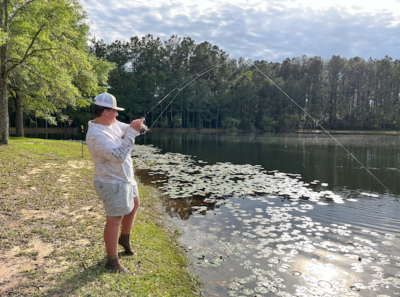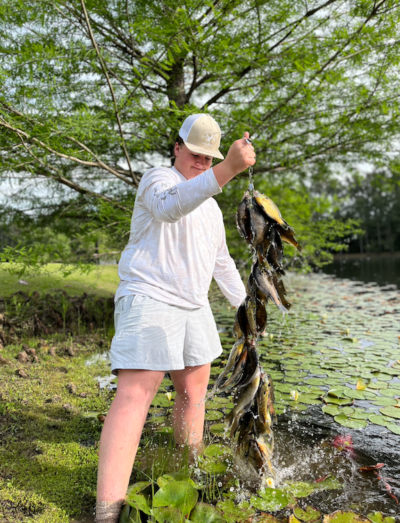Bream on the Bottom
Keith Lusher 08.17.23


It’s a sight that is all too familiar with youngsters. A simple fishing pole rigged with a red and white bobber with a worm rigged on the hook. That’s how Aubrey Posey of Covington La, got his start. It wasn’t until he turned 11 years old that he accidentally discovered that he could skip the cork and fish on the bottom for bream.
“I used to use corks with worms underneath until that day when I accidentally smashed my bobber against a tree while casting,” he said. The youngster debated going back to his garage for another cork but the thought of peddling all the way back to his house for another bobber was out of the question.“I unsnapped my busted cork and decided to make a cast out as far as I could into the pond,” he said. “I started reeling in and felt a few taps. Then I set the hook and reeled up a 6-inch bluegill.” As Posey continued to reel in fish he figured out that bream were grouped along a ledge that went from about four feet to about ten feet. The ledge was about 25 feet from the bank where he was fishing. “There’s no way I would have caught those fish using a cork so I’m glad I was forced to fish on the bottom that day,” he said.
Six years later, Posey continues his bobber-less pursuit of bluegill but he’s perfected his set-up and technique.
Interstate Options
While Posey has been confined to a few neighborhood ponds, he’s now driving and has found that there are lots of ponds along the Interstate that stretches for the Mississippi State Line and Baton Rouge. “I counted over 35 different ponds that are along Interstate 12 from Slidell to Denham Springs,” said Posey. “I just pull up Google Earth and find ones that I haven’t fished, then figure out how I’m going to get to it.” These ponds came about when the interstate was constructed in the 60s. The contractors needed soil to build up the land for the roadway. As a result, numerous ponds that pepper the woods along the interstate. He homes in on these ponds and finds service roads that lead up to them.

Posey’s Bream Busting Bottom Rig
The 17-year-old uses a Daiwa ultralight 5’ medium-fast rod with 6-pound test. For line, he uses Crappie Max Camo monofilament line. He ties a #6 short shank hook onto the end. “You can use a long shank hook also, I just find that the shorter hooks are easier to hide inside the worm than the ones with the long shaft,” he said.
He pegs a very light 1/32 oz. worm weight up from the hook about two feet. The posted worm weight allows the line to be pulled along the bottom without snagging any structure. Posey said he prefers bullet weights but split-shots work as well, however, they do get hung up more than the bullet weights.
Posey recommends using the smaller earthworms that he digs up in his backyard for bait instead of the larger night crawlers that are bought at stores.
When trying to locate bream, Posey walks the shoreline and casts away from the bank, reeling the line back slowly. He casts as far as he possibly can to cover a lot of water. “You can’t reel it too fast or the perch will rip the worm right off the hook,” he said. When he feels a series of taps, he doesn’t stop. He keeps reeling it in until the fish hooks itself.
When he catches a bluegill, he stays put and can usually catch between 10-20 in that same spot. “For some reason, they group up better when they are farther out in the deeper water,” He said. “Maybe it’s just their instinct to stick together in deeper water as protection against bigger bass that may want to have them as a snack.”

Beat the Heat
The spawn is a green time of catch bream, however, Posey waits for the August heat to kick in. “When the temperatures reach the 90s routinely, I’ll start hitting them deep,” he said.
The biggest concern amongst anglers when fishing on the bottom is getting snagged on underwater structure.
Posey said he rarely has any trouble with snags. “I think when they dug these ponds they just bulldozed everything clean because I rarely feel anything on the bottom when I’m reeling in,” he said.
As we turn the page to fall, the bream bite should be consistent until the first few cool fronts pass through. Posey recommends his method of fishing in deep water until the temperatures drop. He even extends a challenge to other bass fishermen. “I’m a bass fisherman at heart but will trade in my bait caster for my ultralight rod any day for this action,” said Posey.

